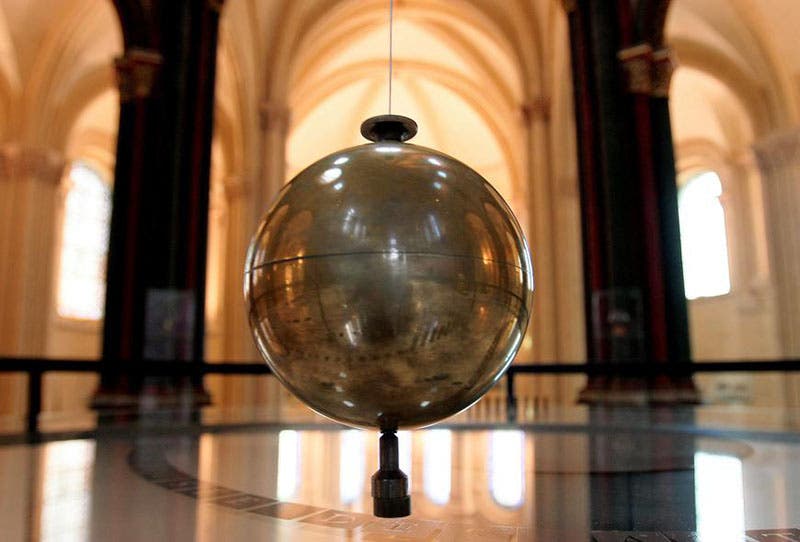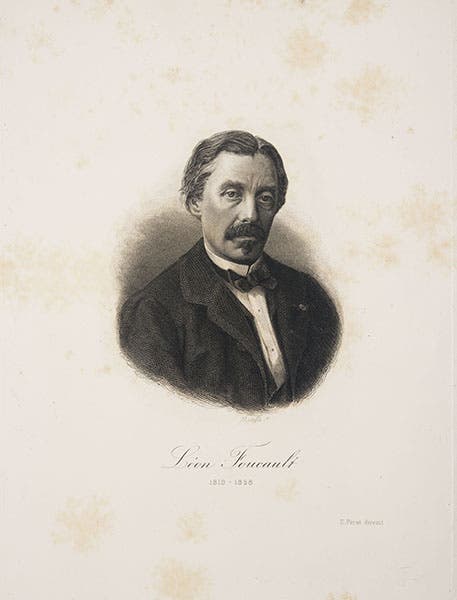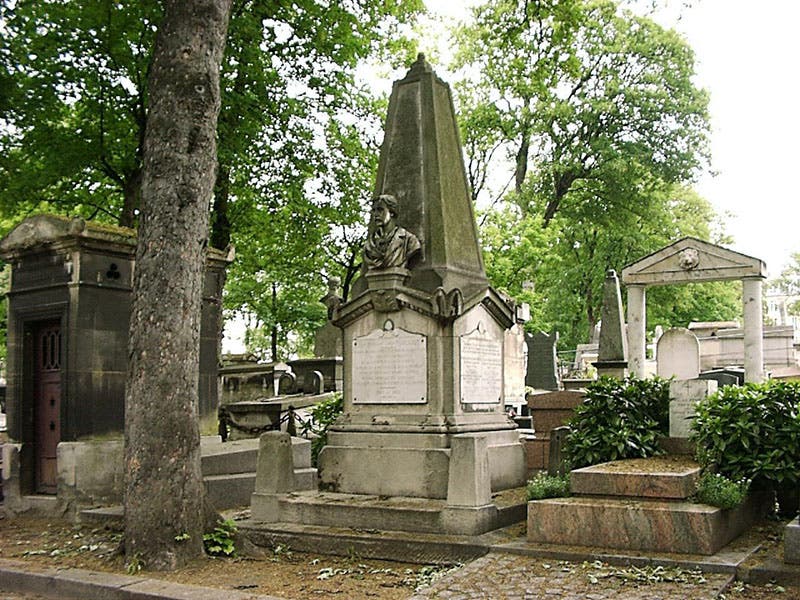Scientist of the Day - Leon Foucault
Léon Foucault, a French physical scientist, was born Sep. 18, 1819. Foucault was a very talented gentleman physicist, which is to say, he never held an academic position. He was one of the pioneers of scientific photography, taking the first daguerreotype of the Sun in 1845. He was one of the first to measure the speed of light in the laboratory, and he built the first practical gyroscope, a device that maintains its direction in space. He later invented the Foucault knife-edge test for figuring telescope mirrors, which for the first time made it possible to build large reflecting telescopes, and indeed he himself built the first reflecting telescope with a ground glass matrix and a silvered surface. But when most people hear the name "Foucault," they think of pendulums.
In March 1851, Foucault hung a pendulum bob from the dome of the Pantheon in Paris. The bob was a lovely brass orb, filled with 60 pounds of lead, and suspended by a stout wire some 220 feet long. The bob swung in a small arc, moving 30 feet across the floor and back, taking 16 seconds to complete one cycle. And with each oscillation, the plane of the pendulum's swing changed direction ever so slightly, although it took at least ten minutes to really notice the veer, as it came to be called (Foucault helped the onlooker’s awareness by putting sand on the floor, so that the pin on the bottom of the bob would make a slightly different groove with each swing). In 32 hours, the plane of the pendulum would rotate through a full 360°. In truth, the plane of the pendulum does not change at all; it remains rigidly fixed in space. Instead, the earth rotates underneath the pendulum. The Foucault pendulum was the first dynamic demonstration of the earth's rotation, 308 years after Copernicus had first proposed it. Above (first image) is the only contemporary illustration we have of the original pendulum in the Pantheon. Foucault’s pendulum became a public sensation, and replicas were soon swinging in lofty spaces all around the world, and still are. Foucault himself installed another pendulum at the Exposition universelle of 1855, France's answer to England's Great Crystal Palace Exhibition of 1851.
Foucault was France's most renowned physicist until 1867. He seemed unstoppable, but unfortunately he suffered a rapid onset of multiple sclerosis in 1867 that proved both agonizing and fatal; he was only 48 years old when he died. He was buried in the Montmarte cemetery in Paris and has a very handsome monument (fifth image).
The bob from the 1855 Foucault pendulum was bequeathed to the Musée des Arts et Metiers in Paris. One of the wings of the museum is a former church, the Priory of Saint- Martin-des-Champs, and the bob (third image) has been suspended from the top of the nave, where it swings regularly for visitors (second image). The original 1851 bob was acquired by the Museum in 1894, but where it is now, they are not saying - it is not on display, or on their website. The Pantheon still has a Foucault pendulum in action, in the original spot where the first one swung in 1851; the bob is a replica of the original, as you can see in a 60-second video. You might notice that the swing has been reduced to about 15 feet, and yet the period is still 16 seconds. That’s the way it is with pendulums, and why they are so suitable for driving clocks.
Umberto Eco's novel, Foucault's Pendulum (1988) starts out in the church of Saint-Martin-des-Champs, where the main character, Casaubon, is watching the pendulum swing and musing about Antoine Lavoisier and secret societies. It moves on from there, but the pendulum returns later in the novel, as pendulums should do, and it is a tale well worth reading.
The portrait of Foucault (fourth image) is from Recueil des travauxs de Foucault (1878), a work we have in our collections.
Dr. William B. Ashworth, Jr., Consultant for the History of Science, Linda Hall Library and Associate Professor, Department of History, University of Missouri-Kansas City. Comments or corrections are welcome; please direct to ashworthw@umkc.edu.










